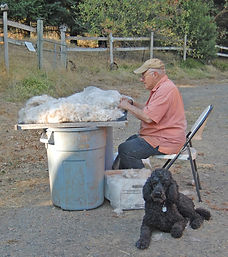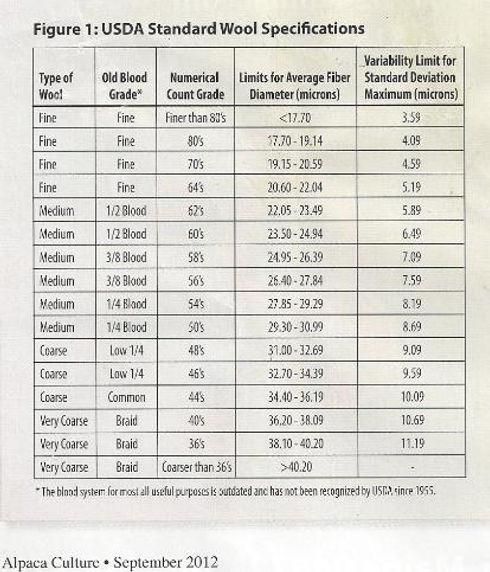EasyGo Farm
Please don't reproduce photos without permission.
About
More About Fleece
Care and preparation
Clean fleeces, desired by handspinners and mills alike, begin with clean pastures. Easier said than done for some of us. Our farm was a filbert (hazelnut) orchard, planted in the1930s, and we valued it for its history as well as its shade. But that meant our alpacas' fleeces pick up bits of bark, nut shells, even twigs.
So the day of shearing, we clean our alpacas. The huacayas are blown out with a "reverse vacuum." Some people actually vacuum their animals, but that hasn't worked as well for us.
The blower seems to matt the suris' fleece very easily, so they are brushed with a rubber curry mitt, designed for horses.
If the fleece is to be entered in a show, we leave it alone; we don't want to destroy its
architecture - the lock structure, crimp, etc. We gently hand pick as much as possible before shearing, then finish the job with the fleece laid out on a skirting table.
The shearer has removed the blanket first, then the neck, and finally the legs; these went into three different bags. The shearer is experienced at clipping these areas separately, but occasionally some leg wool has made its way into the first bag, or possibly part of the blanket is shorter or coarser in one area. The next step is to skirt it - to remove vegetative matter and non-uniform areas.
We* skirt the fleece similarly, whether it is going to a mill, a
handspinner, or a show. We pull out as much debris as possible,
plus any inconsistent patches of fleece. If the alpaca was sick
during the year or suffered any other stress, we test several
locks of fleece for tenderness or breakage.
Although alpaca can be spun straight from the bag, it's usually
dusty enough that most spinners prefer to wash and card or
comb it.
We put batches of fleece into a mesh lingerie bag and fill our
top-loading washer with warm water and a gentle fiber wash
like Unicorn (if you use Dawn, be sure it doesn't have protein
dissolving enzymes) - since there's no lanolin, we don't need to
use hot water.
We gently push the bag of fleece into the water, let it soak for 20 or so minutes, then let the washer spin it. We refill the washer with water of the same temperature and again lower the bag to rinse the fleece, then spin it again. We may need to repeat the washing and rinsing until the water runs clear.
To avoid making felt, we keep the water temperature constant and are careful not to run
water over the fleece or to agitate it.
After it's dried, we run it through the carder. English combs also work well, especially if the fleece has matted.

* When I say "we," I mean Barry.
Email:
bolewicz at netzero dot net

From SpinOff magazine:
"Suri and huacaya fleeces spin somewhat differently, but this is
less significant than the general nature of alpaca.
It is relatively long-fibered and easy to spin, but tends to yield a
yarn that is dense and very warm, making it an excellent choice to spin fine for lace or lightweight items.
It requires more twists per inch because the fibers are smooth,
unlike wool...
Alpaca will felt enthusiastically..."
About alpaca fleece:
The blanket (back and sides) is the prime fiber area.
The neck and upper legs (seconds) produce fiber that is usually
shorter and less uniform - but still spinnable.
Our fleeces are raw (unwashed), clean, and skirted, unless otherwise noted.
Huacaya fleece is similar to wool, with possibly a little less elasticity, but finer with a better hand.
Suri fleece is straight and silky, highly lustrous, with no elasticity but a beautiful drape.
Alpaca fleece contains virtually no grease; you will probably lose less than 5% of the weight after washing (so it's not as expensive compared to sheep's wool as it seems).

Some technical information from the Alpaca Fiber Symposium:
Moisture regain percentage: The amount of water a completely dry fiber will absorb from the air, expressed as a percentage of the dry fiber weight.
*Alpaca - 8%
*Wool - 16%
*Cotton - 8%
*Silk - 9%
Alpaca has half the moisture regain of wool which could account for why it seems more comfortable and breathable than wool.
Class I Fiber category: this means that alpaca is flame resistant.
It is also marginally flame retardant, which means it will self-extinguish.
Wicking test: In knitted or woven fabric, it does wick; in felted fabric, it does not. It is similar to wool in absorbency and wicking.
Abrasion and Pilling: An alpaca blanket scored 3 (on a scale of
1 to 5), which is good pill resistence, especially in woven material. It also had a score of 15,000 cycles of abrasion, which means that itmet upholstery standards.
An Overview of the AOBA Alpaca Fiber Study
What we can say about alpaca fiber:
Alpaca is flame resistant, meeting the standards of
the US Consumer Product Safety Commission's rigid
testing specifications as a Class 1 fiber for use in
clothing and furnishings.
Alpaca is water resistant, making spills easy to clean
up before water saturates the fiber allowing stain to
develop. It is also absorbent to oils, meaning that
the oils do not penetrate the fibers, but merely cling
to the fiber for easy cleaning without harsh chemicals.
Alpaca is resistant to external water penetration like
wool, but can slowly wick away perspiration
because of its unique ability in moisture regain.
These factors are what makes alpaca feel lighter
than wool, but warmer than cotton in cool, damp
conditions.
Alpaca is free of lanolin and thus can be processed
without the need for high temperatures or harsh
chemicals in washing.
Alpaca is a natural renewable fiber with a wide
range of applications.
Everybody loves alpaca.

Please don't reproduce these photos without permission.